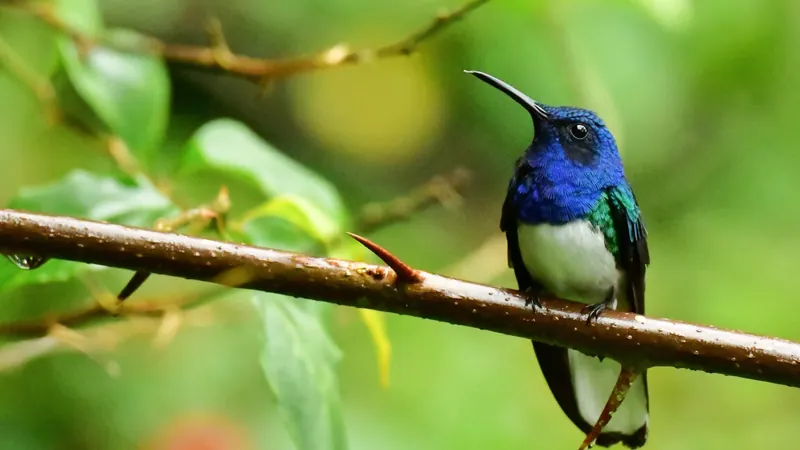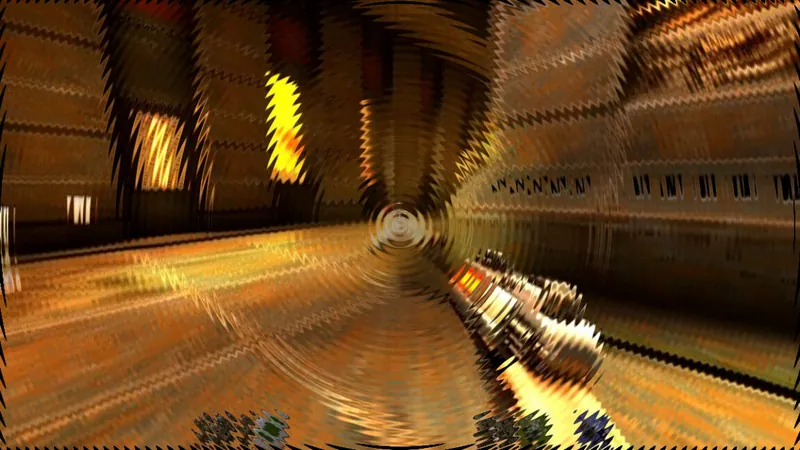
Astonishing Discovery: Hummingbird Hatchling Camouflages as a Toxic Caterpillar!
2025-04-04
Author: Kai
Introduction
In a captivating revelation of nature's ingenuity, the white-necked jacobin (Florisuga mellivora), a dazzling hummingbird native to the neotropical lowlands of South America and the Caribbean, has been found to exhibit a remarkable form of mimicry. This tiny, iridescent bird, known for its shimmering blue and green feathers that glisten in the rainforest sun, has a hatchling that closely resembles a toxic caterpillar—a defense mechanism unseen until now in hummingbirds.
The Discovery
Jay Falk, a National Science Foundation postdoctoral fellow at the University of Colorado, Boulder, and researcher at the Smithsonian Tropical Research Institute (STRI) in Panama, made this groundbreaking discovery while observing nesting behavior in these vibrant birds. Expecting to find the usual sights of a hummingbird nest, he encountered instead an intriguing sight: a newly hatched chick that bore an uncanny resemblance to a poisonous caterpillar. Its long, fine feathers mimicked the urticating hairs found on some caterpillars, which can cause severe reactions in predators.
Batesian Mimicry
Falk noted that this astonishing mimicry is a form of Batesian mimicry—the strategy by which a non-toxic species deceives predators into thinking it is dangerous. The research revealed that the white-necked jacobin's chicks have evolved to appear threatening, undoubtedly an adaptive response to high rates of nest predation in their environment.
Adaptations in Nests
To bolster this remarkable camouflage, mother hummingbirds have been observed lining their nests with fibrous materials from balsa tree seeds, further enhancing the mimicry of their chicks. Remarkably, when approached, these chicks exhibit defensive behaviors that include shaking their heads and ruffling their feathers to imitate a threatening posture. This behavior effectively deters predators, as demonstrated when a wasp, a known threat to young hummingbirds, was scared away by the chick's striking display.
Mimicry Mechanics
The researchers found that the chicks' feather structure, coloration, and movements closely resemble those of certain caterpillar species from the Megalopygidae and Saturniidae families. This sophisticated mimicry not only helps to protect them from danger but may also represent an extraordinary example of convergent evolution, wherein unrelated species evolve similar traits in response to shared environmental pressures.
Significance of Findings
This discovery raises the possibility that the white-necked jacobin may not only be mimicking poisonous caterpillars for protection but that these long feathers could also help with thermal regulation and sensory perception against approaching threats. Such intricate adaptations highlight the complexities of survival strategies in the wild.
Comparative Species
Interestingly, this mimicry phenomenon has been observed in only one other bird species: the cinereous mourner (Laniocera hypopyrra), whose chicks hatch with bright orange spiny feathers resembling another hazardous caterpillar species. As with the jacobin, these chicks also display head-shaking behavior when threatened, emphasizing the evolutionary advantages of such mimicry.
Conclusion
While hummingbirds are traditionally celebrated for their iridescent colors and remarkable flying capabilities, Falk's findings suggest that there is much more to these creatures than meets the eye. Future research into the evolution of mimicry and costume-like adaptations in hummingbirds could unveil even more astonishing aspects of their survival strategies in nature. The findings were published in the journal *Ecology*, capturing the essence of an ecological marvel that showcases the artistry of evolution and adaptation. Keep an eye out for more revelations in our natural world, where surprises await us at every turn!





 Brasil (PT)
Brasil (PT)
 Canada (EN)
Canada (EN)
 Chile (ES)
Chile (ES)
 Česko (CS)
Česko (CS)
 대한민국 (KO)
대한민국 (KO)
 España (ES)
España (ES)
 France (FR)
France (FR)
 Hong Kong (EN)
Hong Kong (EN)
 Italia (IT)
Italia (IT)
 日本 (JA)
日本 (JA)
 Magyarország (HU)
Magyarország (HU)
 Norge (NO)
Norge (NO)
 Polska (PL)
Polska (PL)
 Schweiz (DE)
Schweiz (DE)
 Singapore (EN)
Singapore (EN)
 Sverige (SV)
Sverige (SV)
 Suomi (FI)
Suomi (FI)
 Türkiye (TR)
Türkiye (TR)
 الإمارات العربية المتحدة (AR)
الإمارات العربية المتحدة (AR)